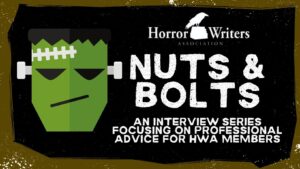Nuts and Bolts: Writing Tips From Master of Horror Joe R. Lansdale

Nuts and Bolts: Writing Tips From Master of Horror Joe R. Lansdale
By Tom Joyce

Joe R. Lansdale is the author of nearly four dozen novels, including Rusty Puppy, the Edgar Award-winning The Bottoms, Sunset and Sawdust, and Leather Maiden. He has received nine Bram Stoker Awards, the American Mystery Award, the British Fantasy Award, and the Grinzane Cavour Prize for Literature. He lives with his family in Nacogdoches, Texas.
Whether it’s horror, a western, or a crime thriller, you’ll never get bored reading a Joe R. Lansdale story. In this month’s edition of “Nuts & Bolts,” the splatterpunk pioneer and multi-genre legend shares some pointers on how he crafts his trademark lean, two-fisted prose.
On writing action sequences and fight scenes:
“I’m not proud of it,” Joe R. Lansdale said in a recent phone interview, “but I’ve been in a lot of fights. You start to learn what’s real and what isn’t.”
He draws on his background as a martial artist, bouncer, and bodyguard from a rough part of East Texas when writing his fight scenes. Most real fights are over fast, he said, and it’s possible to reflect that in your writing while still giving them impact.
“I always think less is more,” he said. “To make it seem like you’ve given a lot of description, but you haven’t. You’ve chosen the right words. You have to write like a cinematographer. I’ve always found that the greatest thing outside experience is stopping and thinking about it from an observational standpoint. The more you do it, the more you’re able to envision that action sequence.”
For action sequences, he recommends short sentences and paragraphs. Another way of injecting a sense of immediacy is to give it a stream-of-consciousness structure, as in: “I spin and dodge his fist, then hit him with …”
“Some people will say that’s a run-on sentence,” he said. “It isn’t, if it’s done right.”
On writing a fast-paced narrative:
Joe said he was influenced by writers such as Edgar Rice Burroughs and Robert E. Howard—the latter of whom was actually writing about the Texas oilfield workers and roughnecks around him.
“Those were people he knew, but he put them in a phantasmagoric sort of world,” Joe said.
Even in thrillers, he said, it’s good to vary the pace and provide some downtime from the action sequences, but that doesn’t mean the story has to grind to a halt. Humor, a sense of haste, or emotions such as anger can drive the narrative. Even descriptions of settings and inanimate objects should move the story forward, he said, and not occur simply because they seem obligatory for that point in the story.
“It’s never time, unless it’s contributing somehow to the narrative,” he said.
When it comes to describing settings and objects, he’d recommend studying Ray Bradbury’s technique.
“He writes likes everything is alive,” he said. “Describe objects with the same care as you would describe characters.”
Done right, he said, a description of a hotel room or grocery store can carry as much impact, and say as much about a character’s situation, as an interaction with another person.
“I always stop and think—am I bored reading my work here, or am I not?” he said.
On keeping people invested in characters who do terrible things:
“It’s not about whether they’re sympathetic, but whether they’re interesting.”
Joe recommends James M. Cain’s approach to writing immoral protagonists in noir classics such as The Postman Always Rings Twice and Double Indemnity.
“They’re like regular people,” he said, “but they’ve made a decision to step over the line. So, they drag some sympathy with them from their former, more humanistic life—for whatever reason: money, power, love, or sex.”
If he could give one piece of advice to beginning writers, what would it be?
“Write like everybody you know is dead, and don’t write for other people. Nobody’s looking over your shoulder—be it an agent, an editor, what have you. When you try to please everybody, you may look in the mirror someday and realize you’re not pleasing yourself.”
Any projects he’d like HWA members to know about?
The Doughnut Legion, which he describes as “really a crime novel, but elements of horror and science fiction blend in with the story. There are times where you don’t know exactly where it’s going and how dark it is. I think it’s a good mystery and a good story altogether.”
Where should people follow him online?
Watch for more “Nuts & Bolts” interviews on the craft and business of writing horror, along with instructive videos on the HWA’s Tik Tok channel. In upcoming installments, Bram Stoker Award nominee Robert Ottone gives a behind-the-scenes look at running a small press and award-winning writer/director John Penney discusses the similarities and differences of writing screenplays vs. novels. Also, some volunteers from the HWA’s mentorship programs will be sharing videos with tips you can use in your own writing. Please contact me at TomJHWA@gmail.com if you have any suggestions for future interviews. For more about what I’m looking for, see here https://horror.org/about-nuts-bolts-practical-advice-for-horror-writers/ – Tom Joyce



